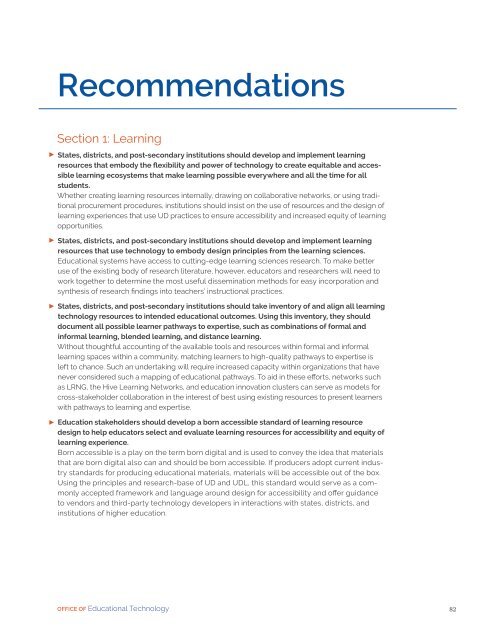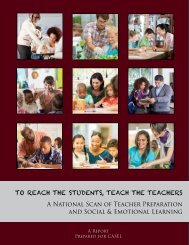Future Ready Learning
7m3sdJ
7m3sdJ
You also want an ePaper? Increase the reach of your titles
YUMPU automatically turns print PDFs into web optimized ePapers that Google loves.
Recommendations<br />
Section 1: <strong>Learning</strong><br />
States, districts, and post-secondary institutions should develop and implement learning<br />
resources that embody the flexibility and power of technology to create equitable and accessible<br />
learning ecosystems that make learning possible everywhere and all the time for all<br />
students.<br />
Whether creating learning resources internally, drawing on collaborative networks, or using traditional<br />
procurement procedures, institutions should insist on the use of resources and the design of<br />
learning experiences that use UD practices to ensure accessibility and increased equity of learning<br />
opportunities.<br />
States, districts, and post-secondary institutions should develop and implement learning<br />
resources that use technology to embody design principles from the learning sciences.<br />
Educational systems have access to cutting-edge learning sciences research. To make better<br />
use of the existing body of research literature, however, educators and researchers will need to<br />
work together to determine the most useful dissemination methods for easy incorporation and<br />
synthesis of research findings into teachers’ instructional practices.<br />
States, districts, and post-secondary institutions should take inventory of and align all learning<br />
technology resources to intended educational outcomes. Using this inventory, they should<br />
document all possible learner pathways to expertise, such as combinations of formal and<br />
informal learning, blended learning, and distance learning.<br />
Without thoughtful accounting of the available tools and resources within formal and informal<br />
learning spaces within a community, matching learners to high-quality pathways to expertise is<br />
left to chance. Such an undertaking will require increased capacity within organizations that have<br />
never considered such a mapping of educational pathways. To aid in these efforts, networks such<br />
as LRNG, the Hive <strong>Learning</strong> Networks, and education innovation clusters can serve as models for<br />
cross-stakeholder collaboration in the interest of best using existing resources to present learners<br />
with pathways to learning and expertise.<br />
Education stakeholders should develop a born accessible standard of learning resource<br />
design to help educators select and evaluate learning resources for accessibility and equity of<br />
learning experience.<br />
Born accessible is a play on the term born digital and is used to convey the idea that materials<br />
that are born digital also can and should be born accessible. If producers adopt current industry<br />
standards for producing educational materials, materials will be accessible out of the box.<br />
Using the principles and research-base of UD and UDL, this standard would serve as a commonly<br />
accepted framework and language around design for accessibility and offer guidance<br />
to vendors and third-party technology developers in interactions with states, districts, and<br />
institutions of higher education.<br />
OFFICE OF Educational Technology<br />
82



